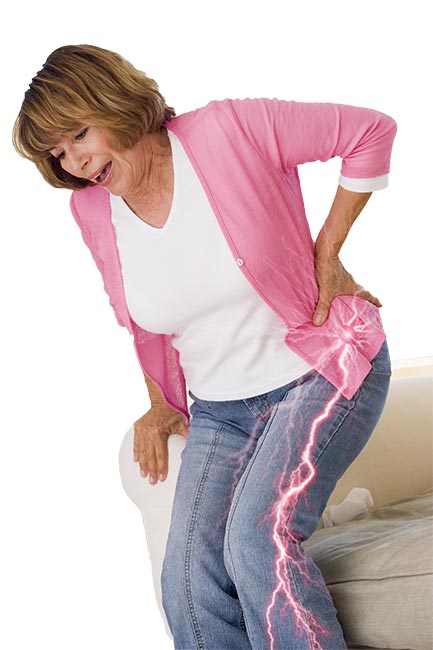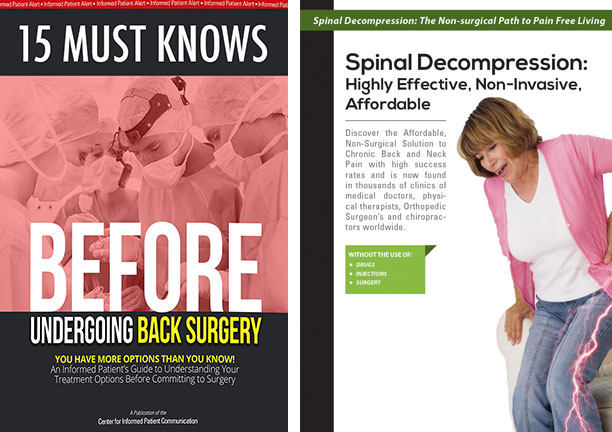 Sciatica is pain associated with the sciatic nerve which usually originates higher along the spinal cord when nerve roots become compressed or damaged from narrowing of the vertebral column or from a slipped or herniated disc. Symptoms can include tingling, numbness, or pain, which radiates to the buttocks, legs and feet.
Sciatica is pain associated with the sciatic nerve which usually originates higher along the spinal cord when nerve roots become compressed or damaged from narrowing of the vertebral column or from a slipped or herniated disc. Symptoms can include tingling, numbness, or pain, which radiates to the buttocks, legs and feet.
What is the Sciatic Nerve?
The Sciatic nerve is the main nerve traveling down the leg. This nerve starts in the spine and runs down the back of each leg into the feet. This nerve controls the muscles of the back of the knee and lower leg and provides sensation to the back of the thigh, part of the lower leg, and the sole of the foot.
What causes Sciatica
Common causes of Sciatica include:
- Piriformis syndrome – The piriformis muscle, located in the buttocks, becomes tight and or spasmed and irritates the Sciatic nerve.
- Slipped Disc, Herniated Disc, Bulged Disc – A herniated or bulging disc can push out (like squeezing the jelly out of a jelly doughnut) and irritate the nerve root of the sciatic nerve causing sciatica.
- Degenerative Disc Disease
- Spinal Stenosis, narrowing of the canal
What does Sciatica Feel Like?
How Do I Know If I Have Sciatica?
Sciatic pain can vary widely. It may feel like a mild tingling, dull ache, or a burning sensation. Some patients describe it as a “hot poker” or a shooting electrical pain in the buttocks and down the leg. Often times the pain will shoot down the leg into the foot and have accompanied numbness and tingling in the leg and foot. In some cases, the pain is severe enough to make a person unable to move.
The pain most often occurs on one side. Some people have sharp pain in one part of the leg or hip and numbness in other parts. The sensations may also be felt on the back of the calf or on the sole of the foot. The affected leg may feel weak.
It is always important to consult a qualified physician to determine the cause and best course of action for your sciatica. Success of sciatica treatment is determined by the ability of the physician to determine the exact cause of the sciatica and have the tools necessary to treat that underlying cause.
What are My Options for the Treatment of Sciatica?
Your doctor may prescribe different therapies depending on the cause of sciatica. Often times stretching, ice and rest are enough to allow the pain and inflammation associated with sciatica to self resolve. If pain persists longer than a week or two then your doctor may recommend spinal decompression.
How does Spinal Decompression help Sciatica?
Non-Surgical Spinal Decompression slowly lengthens and decompresses the spine, creating negative pressures within the discs. This reversal of pressure creates a vacuum inside the discs that helps to reposition bulging discs and draw extruded disc material back into place, taking pressure off pinched nerves. Spinal experts believe that nutrients, oxygen, and fluids are drawn into the disc to create a revitalized environment conducive to healing.
What are the Treatments Like?
At the beginning of each session, you will be comfortably fitted with a harness designed to achieve optimal decompression of the low back or neck. During a session of spinal decompression, you will notice a slow lengthening of your spine as your discs are gradually decompressed and relieved of pressure. The treatment process is safe and relaxing. While some patients with extensively injured discs have reported mild discomfort during the first few treatment sessions, their discomfort generally subsides upon subsequent visits. A patient safety switch provides an extra safety feature, allowing you to stop at any point should you feel discomfort. Each treatment session lasts approximately 30 minutes. Individual patient results may vary.
What is the Typical Treatment Protocol?
A typical spinal decompression treatment protocol consists of about 12-20 sessions over four to six weeks. Some conditions require fewer visits; some require more. Many patients report relief from their pain and other symptoms during the first few treatment sessions, and most experience dramatic pain relief after completion of their prescribed treatment program.
Why Is Spinal Decompression Different from Traction, Physical Therapy and Chiropractic Manipulation?
While traction, physical therapy, and manipulation may reduce disc pressures to as low as 40 mm Hg, only spinal decompression has been shown to achieve negative pressures within the spine. It has been clinically proven that spinal decompression creates negative pressures as low as -110 mm Hg3 within the injured disc during the treatment session. Normally, pulls exerted on the spine trigger sensory receptors in the back to tighten the muscles surrounding the vertebrae and discs in an effort to protect them from injury. Spinal Decompression bypasses this response by slowly pulling on the spine and relaxing the back over an extended period of time, allowing the spine to be repositioned without tension and without causing spasm and muscle guarding. It is important for patients to make sure that they are treated on a high quality true spinal decompression table by a physician with years of experience and not an imitation spinal decompression table.
Is it true that research has shown up to 88.9% success rate for spinal decompression?
Yes! More than 10 research articles have shown success rates for spinal decompression to be up to 88.9%. In fact John Leslie M.D. and the Mayo Clinic reported at the 18th Annual Meeting American Academy of Pain Management in Tampa Florida on September 5, 2007 the following amazing statistics:
- Multi-center, phase II, non-randomized pilot study utilizing spinal decompression.
- Designed to evaluate the effectiveness and safety of spinal decompression in the treatment of chronic lower back pain.
- Patients enrolled an average of ten years of chronic back pain.
- After two weeks of treatments of spinal decompression — 50% reduction in pain scores.
- Upon completion of the entire six week protocol success rate of 88.9% was documented.
Is it true that professional athletes, celebrities and patients in their 90s have turned to Spinal Decompression and Cold Laser Therapy as a successful, non-surgical option to neck and back pain without the use of drugs, pills and surgery?
Yes! Professional athletes, celebrities and even patients in their 90s are turning to spinal decompression and cold laser therapy as an affordable, non-surgical alternative to neck and back pain without the use of drugs, pills and surgery. People are tired of taking pills that simply mask the pain and can cause all kinds of serious side effects. People are frustrated with getting shots that work the first time or two and then eventually have minimal or no effect. And people are scared to death of surgery as they have seen firsthand their friends and relatives who spent 1,000s of dollars, had weeks of “down time”, have scars, and risked serious side effects and still ended up with a “failed back surgery syndrome”. New non-surgical spinal decompression is not only effective and affordable but is also non-invasive and safe.
©1998-2010 Mayo Foundation for Medical Education and Research (MFMER). All rights reserved. A single copy of these materials may be reprinted for noncommercial personal use only. “Mayo,” “Mayo Clinic,” “MayoClinic.com,” “EmbodyHealth,” “Enhance your life,” and the triple-shield Mayo Clinic logo are trademarks of Mayo Foundation for Medical Education and Research.
References
- Clarke JA, van Tulder MW, Blomberg SE, et al. Traction for low-back pain with or without sciatica. Cochrane Database Syst Rev. 2007;(2):CD003010.
- Chou R, Qaseem A, et al. Diagnosis and treatment of low back pain: a joint clinical practice guideline from the American College of Physicians and the American Pain Society. Ann Intern Med. 2007;147(7):478-491.

